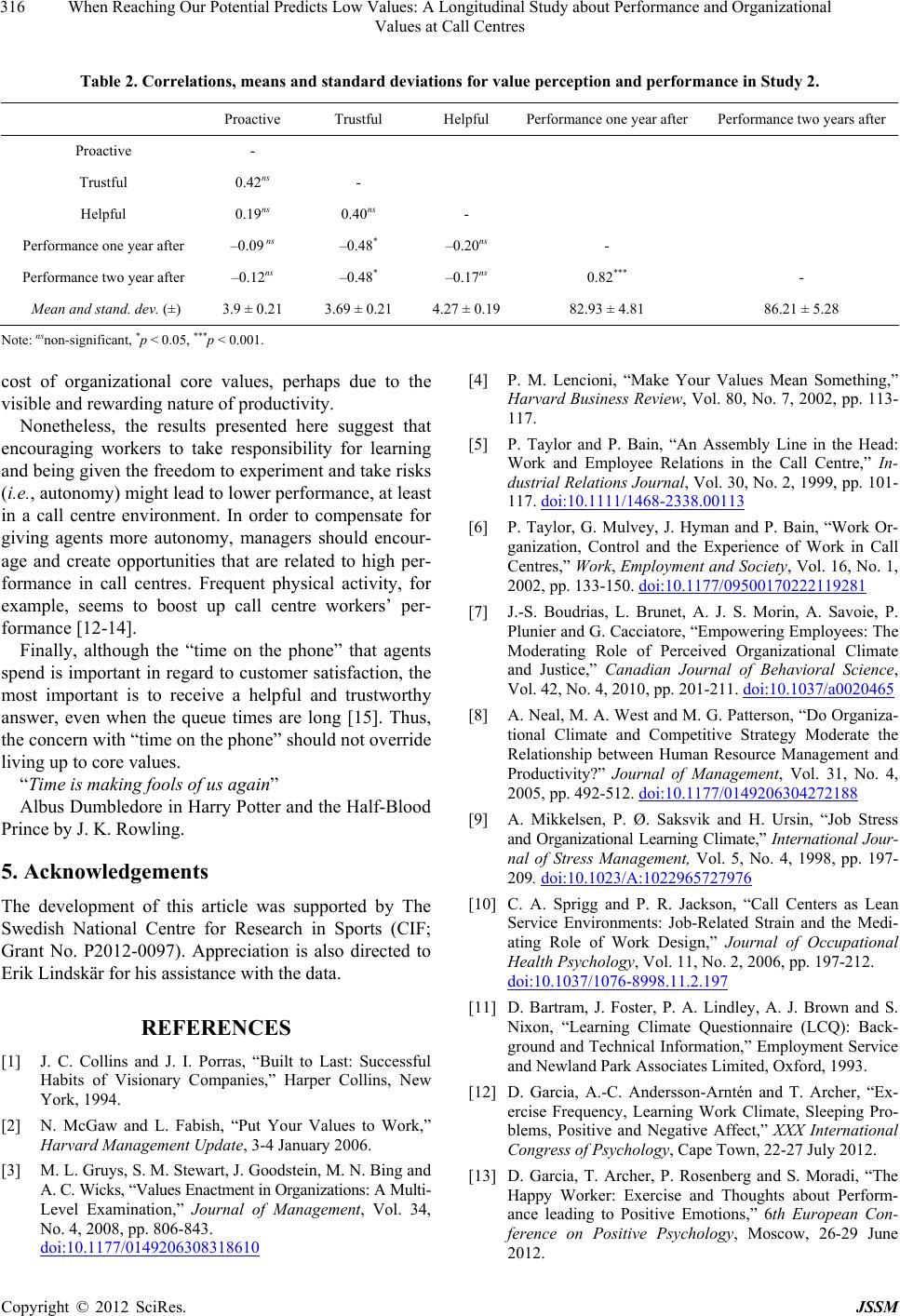
When Reaching Our Potential Predicts Low Values: A Longitudinal Study about Performance and Organizational
Values at Call Centres
316
Table 2. Correlations, means and standard deviations for value perception and performance in Study 2.
Proactive Trustful Helpful Performance one year after Performance two years after
Proactive -
Trustful 0.42ns -
Helpful 0.19ns 0.40ns -
Performance one year after –0.09 ns –0.48* –0.20ns -
Performance two year after –0.12ns –0.48* –0.17ns 0.82*** -
Mean and stand. dev. (±) 3.9 ± 0.21 3.69 ± 0.21 4.27 ± 0.1982.93 ± 4.81 86.21 ± 5.28
Note: nsnon-significant, *p < 0.05, ***p < 0.001.
cost of organizational core values, perhaps due to the
visible and rewarding nature of productivity.
Nonetheless, the results presented here suggest that
encouraging workers to take responsibility for learning
and being given the freedom to experiment and take risks
(i.e., autonomy) might lead to lower performance, at least
in a call centre environment. In order to compensate for
giving agents more autonomy, managers should encour-
age and create opportunities that are related to high per-
formance in call centres. Frequent physical activity, for
example, seems to boost up call centre workers’ per-
formance [12-14].
Finally, although the “time on the phone” that agents
spend is important in regard to customer satisfaction, the
most important is to receive a helpful and trustworthy
answer, even when the queue times are long [15]. Thus,
the concern with “time on the phone” should not override
living up to core va lues.
“Time is making fools of us again”
Albus Dumbledore in Harry Potter and the Half-Blood
Prince by J. K. Rowling.
5. Acknowledgements
The development of this article was supported by The
Swedish National Centre for Research in Sports (CIF;
Grant No. P2012-0097). Appreciation is also directed to
Erik Lindskär for his assistance with the data.
REFERENCES
[1] J. C. Collins and J. I. Porras, “Built to Last: Successful
Habits of Visionary Companies,” Harper Collins, New
York, 1994.
[2] N. McGaw and L. Fabish, “Put Your Values to Work,”
Harvard Management Update, 3-4 January 2006.
[3] M. L. Gruys, S. M. Stewart, J. Goodstein, M. N. Bing and
A. C. Wicks, “Values Enactment in Organizations: A Multi-
Level Examination,” Journal of Management, Vol. 34,
No. 4, 2008, pp. 806-843.
doi:10.1177/0149206308318610
[4] P. M. Lencioni, “Make Your Values Mean Something,”
Harvard Business Review, Vol. 80, No. 7, 2002, pp. 113-
117.
[5] P. Taylor and P. Bain, “An Assembly Line in the Head:
Work and Employee Relations in the Call Centre,” In-
dustrial Relations Journal, Vol. 30, No. 2, 1999, pp. 101-
117. doi:10.1111/1468-2338.00113
[6] P. Taylor, G. Mulvey, J. Hyman and P. Bain, “Work Or-
ganization, Control and the Experience of Work in Call
Centres,” Work, Employment and Society, Vol. 16, No. 1,
2002, pp. 133-150. doi:10.1177/09500170222119281
[7] J.-S. Boudrias, L. Brunet, A. J. S. Morin, A. Savoie, P.
Plunier and G. Cacciatore, “Empowering Employees: The
Moderating Role of Perceived Organizational Climate
and Justice,” Canadian Journal of Behavioral Science,
Vol. 42, No. 4, 2010, pp. 201-211. doi:10.1037/a0020465
[8] A. Neal, M. A. West a nd M. G. Patterson, “Do Organiza-
tional Climate and Competitive Strategy Moderate the
Relationship between Human Resource Management and
Productivity?” Journal of Management, Vol. 31, No. 4,
2005, pp. 492-512. doi:10.1177/0149206304272188
[9] A. Mikkelsen, P. Ø. Saksvik and H. Ursin, “Job Stress
and Organizational Learning Climate,” International Jour-
nal of Stress Management, Vol. 5, No. 4, 1998, pp. 197-
209. doi:10.1023/A:1022965727976
[10] C. A. Sprigg and P. R. Jackson, “Call Centers as Lean
Service Environments: Job-Related Strain and the Medi-
ating Role of Work Design,” Journal of Occupational
Health Psychology, Vol. 11, No. 2, 2006, pp. 197-212.
doi:10.1037/1076-8998.11.2.197
[11] D. Bartram, J. Foster, P. A. Lindley, A. J. Brown and S.
Nixon, “Learning Climate Questionnaire (LCQ): Back-
ground and Technical Information,” Employment Service
and Newland Park Associates Limited, Oxford, 1993.
[12] D. Garcia, A.-C. Andersson-Arntén and T. Archer, “Ex-
ercise Frequency, Learning Work Climate, Sleeping Pro-
blems, Positive and Negative Affect,” XXX International
Congress of Psychology, Cape Town, 22-27 July 2012.
[13] D. Garcia, T. Archer, P. Rosenberg and S. Moradi, “The
Happy Worker: Exercise and Thoughts about Perform-
ance leading to Positive Emotions,” 6th European Con-
ference on Positive Psychology, Moscow, 26-29 June
2012.
Copyright © 2012 SciRes. JSSM